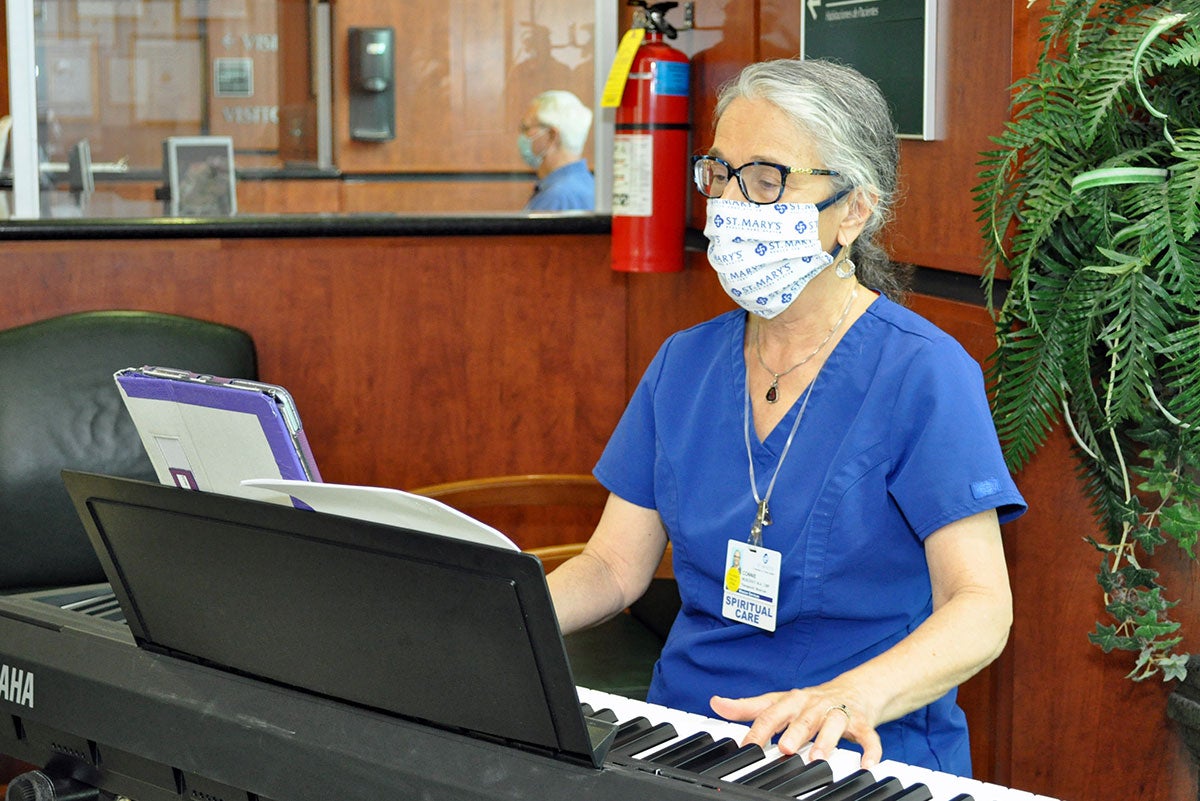Therapeutic Music: Creating a Calming Environment Through Sound
June 15, 2022
Therapeutic music can help patients and family members by taking their mind off the stress of being in the hospital.
St. Mary’s is proud to partner with certified music practitioner Connie Muscenti to bring soothing, live piano music to our patients and staff. In this interview with Marketing intern Laurel May, Connie describes therapeutic music and its many benefits.
What is therapeutic music?
Therapeutic music is music at the bedside played by a live musician to create an environment of healing for a variety of medical conditions.
How does the patient benefit from therapeutic music?
Therapeutic music can help patients and family members by taking their mind off the stress of being in the hospital. The music has a way of calming your parasympathetic nervous system. It helps take away the fight-or-flight response you go through when you’re scared. It creates a healing environment by taking you out of that fearful state and allows you to relax, which can promote healing psychologically and possibly in other ways, too.
How do you decide what to play for a particular patient or family?
After I learn about the patient’s medical condition from a nurse or doctor, I go to the patient and introduce myself. From that moment on I’m observing how that patient is responding and following the family dynamics, if there are family members visiting. If there’s a monitor, I try to look for areas of concern, like high blood pressure, rapid heart rate, low oxygen levels, etc. If the patient is responsive I may chat with the patient to get a feel for the patient’s mood, emotional state, pain issues, and stress level. I choose the style of how I will play the music based on all that. There are certain, explicit styles of playing regarding pain, breathing issues, high anxiety, dpend of life, etc. What’s really great for me is that I can play music that I love and make it work for the patient. It allows for a lot of variety for me as the musician.
What kinds of music do you play?
As a live therapeutic musician (LTM), I can use any kind of music. The essential thing is to play the music in a style appropriate for the condition of the patient. I use improvised or arranged music from many genres, including folk, classical, jazz, soft rock, show tunes, movies, international, Celtic, and new age. I’ve recently found some appropriate music by Japanese composers and Ukrainian composers. I avoid playing any religious music unless patients request it because it’s very important that I honor and respect differences in spiritual preferences, which also include those who may be atheist or agnostic. Music for end of life may be quite different, more about providing sounds that may be soothing and entraining, but usually not recognizable.
Does the patient have to do anything?
No. Whoever is listening simply listens. They don’t actively have to do something or fulfill goals, which makes live therapeutic music different from music therapy. Therapeutic music is played with the intention of directing the sound and energy to the listener. The certified music practitioner watches for common signs or signals (relaxation, physical body movements, falling asleep, etc.) and adjusts the music based on the listener.
So the listener’s response shapes your musical choices for them?
Yes. I immediately try to meet the patient where they are. For example, if they are extremely stressed, hyperactive, or upset, I’ll actually play something that meets their energy. As the patient begins to entrain with what I’m playing I begin to gradually change the mood/style of playing to bring the patient to a calmer, quieter place. Many times, the patient reports feeling much more relaxed and often the patient actually goes into a deep sleep. I’ve also had patients and family members who have been so very stressed begin to let down by crying. All that held-in stressful energy begins to dissipate.
Recently I was in the NCCU (Neonatal Critical Care Unit) in Gainesville and a preemie was very, very distraught and wouldn’t stop crying, no matter how much the nurses tried to comfort him. I happened to be playing out in the nurses station and asked the nurse if she would like me to go to the baby’s bedside and play for him. She agreed that it may be worth a try. I began to play, following the rise and fall of the baby's tummy as he was crying. I entrained with him and after a few minutes when I could tell that we were in sync, I began to gradually slow down the tempo. After a while, he began to yawn and eventually he entrained with my slower, lullaby style of playing and fell sound asleep.
One of the sweetest things I often observe while I'm playing therapeutic music is when a loved one of someone who's ill will lean in close and reach for their loved one's hand. Being witness to the deep commitment and love that the music often seems to bring out for couples and families always reminds me of how powerful music can be.
When should someone seek out therapeutic music?
Anyone hospitalized with any medical condition can benefit from therapeutic music because the main goal is to help them have a better healing environment during their stay. Whoever would like to listen to therapeutic music may request it. In addition, the nurses may suggest which patients would benefit from the music. Before playing, the certified music practitioner asks for confirmation by explaining to the listeners what therapeutic music is and that they may choose to accept or decline.
How long does a typical session last?
Twenty minutes seems to be about the amount of time it takes for a patient to respond to the music, but having said that, I’ve had patients fall asleep within 5 or 10 minutes, and others who never seem to fall asleep but they report deep relaxation. I stay as long as I feel I am being helpful. One thing I do tell all the responsive patients who accept a LTM session is that they are in charge – they may ask me to stop at any time.
What is your background? How did you get into therapeutic music?
I have bachelor and master’s degrees in music education, my main instrument being the piano. My career was originally as a general music educator in the public schools, K-12, as well as a private and group piano teacher in my own studio and also for a bit at the university level. I decided that I really wanted to do something different when my husband and I moved to Athens from Virginia in 2015. I researched different possibilities and decided to take a chance and sign up for the first required courses to become a Certified Therapeutic Musician through a program called Music for Healing and Transition. It was a perfect match for me. And then I discovered Strings of Mercy, a non-profit in Georgia founded by Chuck Beckman, who became my mentor. Playing therapeutic music has been one of the most fulfilling aspects of my music career.
Is there a way I can support Strings of Mercy?
Yes. Go to https://stringsofmercy.org/ to donate to a benefit concert St. Mary’s and Strings of Mercy will hold Aug. 13 at Hendershots Coffee Bar in Athens. “The Power of Music: Discovering the Magic of Live Therapeutic Music” will feature a variety of musicians, including Klezmer Local 42, the Kate Morrissey Band, and others. Proceeds will help Strings of Mercy develop and fund new live therapeutic music programs at healthcare facilities in Athens-Clarke County and will also provide scholarships for local musicians to become certified music practitioners through Music for Healing and Transition.
Where can I find more information about therapeutic music at St. Mary’s?
Listen to the “Music, Dogs, and Prayer: Caring for Body, Mind and Spirit” episode of the Mission in Action podcast.



